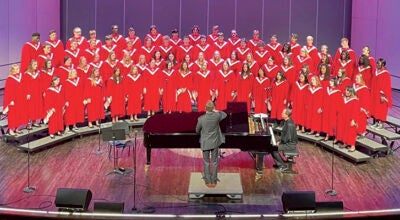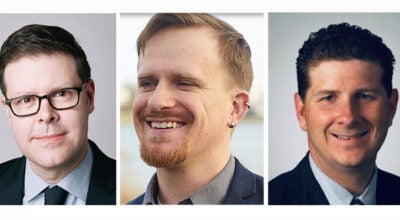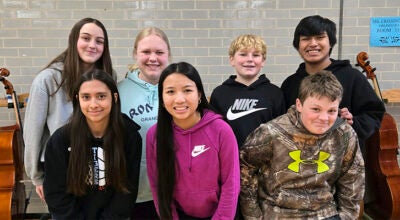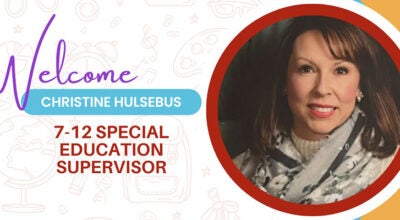Teachers wanted: Districts introduce students to teaching
Published 10:09 am Saturday, September 22, 2018
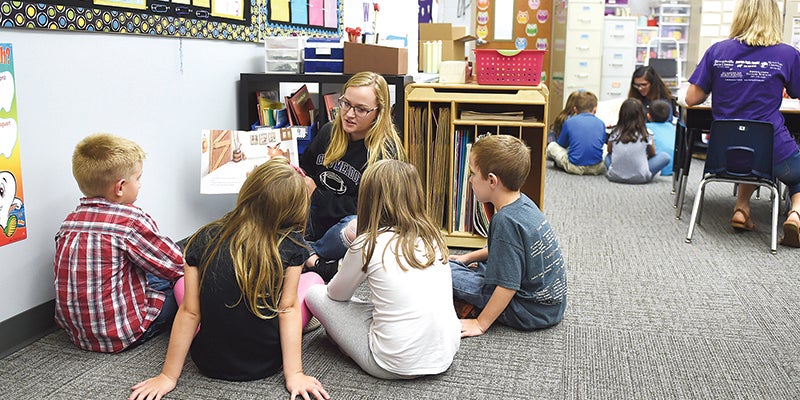
- Grand Meadow student Elizabeth Jacobsen reads to first-graders Friday afternoon. Jacobsen is in a class that introduces students to teaching to determine if they have enough of interest to pursue it in college. Eric Johnson/photodesk@austindailyherald.com
Inside a brightly decorated classroom sat five Grand Meadow High School students and middle school reading and language arts teacher, Jodi Munson. They weren’t in class for a lesson or for reading. They were learning how to teach.
These students were exploring the possibility of seeing themselves as educators in the future, and find delight in working with younger peers to find out if a career as a teacher would be the right one for them if they decide to go to college and work on their degree.
“I took the class because I wanted to go into teaching,” said Elizabeth Jacobsen, senior, who works with kindergarten students. “It’s been fun working with students and seeing if teaching is for me.”
“I like working with kids,” said Donovan Swanson, junior, who works with sixth graders. “I wanted to extend that into possibly being a teaching.”
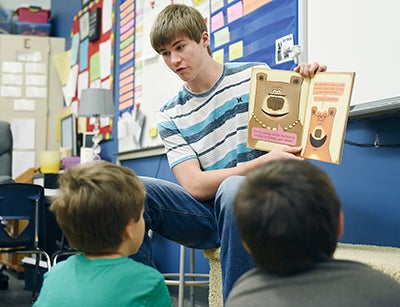
Grand Meadow’s Ethan Gilbert reads to first-graders. Eric Johnson/photodesk@austindailyherald.com
Fellow junior Ethan Gilbert, who works with first graders, also agreed, stating that he had two younger cousins who he often watched after that contributed to his curiosity about education and teaching.
“I wanted to give this a shot,” he said. “I want to see if this is something that I want to do five years down the road.”
Some weren’t interested in becoming teachers, but were interested in working with youth later down the road and wanted to learn how to interact with children in professions that may require some external knowledge.
“I don’t want to be a teacher,” said Jazmyn Ottman, a senior who works with kindergarten students. “I do want to go into pediatrics and I want to learn how to communicate with kids.”
Grand Meadow High School was one of several schools approved for a grant from South Minnesota State University (SMSU) to directly address forecasted teacher shortages statewide. Education 101 is a grant program to explore teaching as well as give prospective teachers “a small taste” of what it’d be like becoming an educator, as well as getting students into classrooms much earlier to see if teaching would be for them.
When students take the course and complete, they are eligible for three college credits that are transferable to any state school, as well as receiving high school credit.
While working in classrooms, students in Education 101 are able to work with a variety of grade levels from pre-kindergarten to primary school to secondary school-aged children, which also provides additional opportunities for them to learn which grade fits them best.
“We’re hoping it’ll continue in the future,” said Principal Jacob Schwarz. “Teacher shortages are a problem throughout the United States, especially in the rural communities. It has been a good addition to give our kids some exposure to the field of teaching.”
From the Minnesota Department of Education’s 2017 Teacher Supply and Demand Report, the average percentage of teachers leaving the profession after one year is 15.1 percent, and over a quarter of the teachers leaving the profession after three years is 25.9 percent.
Also reported by the MDE was that the number of teachers leaving their positions increased to 34 percent since 2008-09, and the largest number of teachers leave because of retirement, personal reasons, or because they got another job in another district.
When Schwarz first started in his educational career, he remembered the competitiveness there was to be able to become a teacher. There would be a couple hundred applicants for a single position, and now, there’s barely two or three going for positions, or some postings remain unanswered.
“It definitely changed in the last 15 years since I’ve been in education,” Schwarz, who’s in his third year with Grand Meadow, said. “In general, small rural schools don’t get the number of candidates larger districts draw. This may be a way to combat that a little bit.”
Several of these topics come up during the 15-week class taken each semester. As Munson teaches her students about techniques and widening their perspective on the classroom environment, she also addresses current issues, such as the teacher shortages and high burnout rate.
“This type of program opens doors for these guys,” Munson said. “We want to grow our own teachers. I do hope when they go to college, get their degree, they may come back to Grand Meadow and become teachers in the place where it all started.”
However, these students aren’t just learning about teaching in textbooks. They are also inside classrooms working with students applying what they learned, and eventually, will have to teach a full 55-minute class toward the end of the semester.
“I’m a little nervous about it,” said Courtney Krumm, a senior who works with three-year-old children in Galaxy Kids. “But, I’m working through it.”
Munson stated that often times, prospective teachers don’t get into the classroom until their final years of college when they’re student teaching, and may have found out too late that teaching wasn’t for them and have ended up wasting money on the degree. She also shared the reality of teaching, where many have to depend on their own money to procure school supplies for their classrooms.
Munson witnessed this firsthand when her mother, also a teacher, had always sought for ways to get funding in order to get the proper materials for her students when funding would fall through. This type of reality, Munson said, she wanted her Education 101 students to be aware of.
“I want kids to take away from this course an appreciation for teachers,” she said. “I think it’s opened their eyes to why teachers do what they do, and what exactly goes into teaching. I hope they get a greater respect for teaching, even for their life lessons. I’m not sugar coating it, teaching is a challenging job. This is not an 8 to 4 job. It’s a challenging job, but it’s also the most rewarding job.”
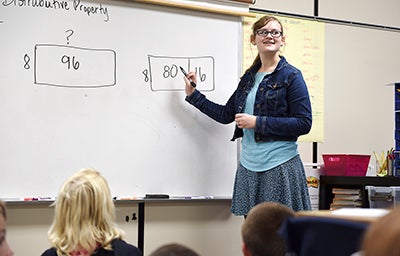
Hayfield senior Matti Morris helps teach a match class at Hayfield Elementary. While not the same program, Hayfield does offer a mentoring-type program to expose students to teaching. Eric Johnson/photodesk@austindailyherald.com
Teacher Academy
Other area school districts in southeast Minnesota are also looking to introduce students to education as a potential career field.
Over at Hayfield High School, the second year of Teacher Academy has started. An elective that’s available to students, the course allows individuals to explore the education field as a whole, while learning how the brain functions, according to Jana Wagner, Teacher Academy instructor.
During the year, Teacher Academy offers hands-on activities and discussion as well as teaching in different grade levels and subjects that best fit the student. After learning about cognitive abilities of different age groups and trends in education, students would begin implementing lessons within a classroom with a teacher or mentor.
If a student enjoyed the course during the first semester, they’d be able to continue with a teacher and be responsible for lesson plans and delivery inside a classroom during second semester.
Last year, there were four students enrolled in the program. Three of them discovered after taking the course that teaching wasn’t meant for them, and one decided to continue pushing forward to become a teacher despite getting discouraged from others.
“There’s a lot more to teaching than meets the eye,” Wagner said. “The public’s perception is that it’s easier than it is. But, it’s a job you take home. You’re caring for kids, especially when you live in the community.You don’t know how much work it is, and there’s so many things that go into it…it’s not easy.”
Teacher shortages affected Hayfield too, according to Principal Grant Klennert. He recalled seeing fewer candidates applying for specific areas such as special education, math and chemistry. With the aim of Teacher Academy, there’s hope that more students would become prepared to enter the education career field with more insight to what’s expected of them, as well as enticing them, with potential opportunities to work for the district in the future.
“This is a program that would hopefully channel students and expose them to education,” Klennert said. “We hope to cultivate ethat passion and get them much sooner into a classroom before going into college. To be a really outstanding teacher, they would go beyond their contract and school day. Students don’t see the planning, the modifying, the understanding of material. These are smaller pictures and opens their eye to a greater picture.”
For those looking or considering a path into education, taking part in a program specifically designed to help expose the realities of education and learning what it takes may prove to be beneficial in the long run. Whether it’d be to discover that being a teacher is not for them, or to reaffirm their passion.
“I’m more confident going into the field,” said Matti Morris, senior and graduate from Teacher Academy. “I’ve had a couple people tell me ‘why would you be a teacher?’ They created some doubt, and said that I could be doing something more with my mind. Being a teacher is like a superhero. It’s selfless work and they have the ability to impact students for life, and for me to help do that is incredible.”


